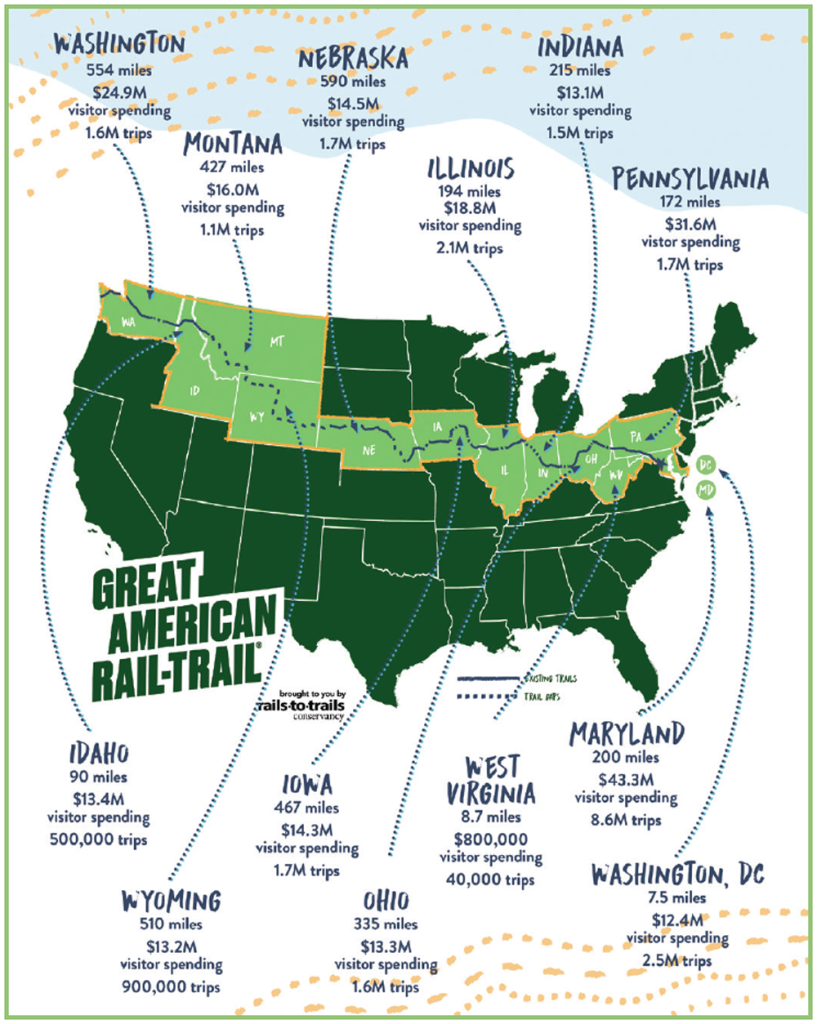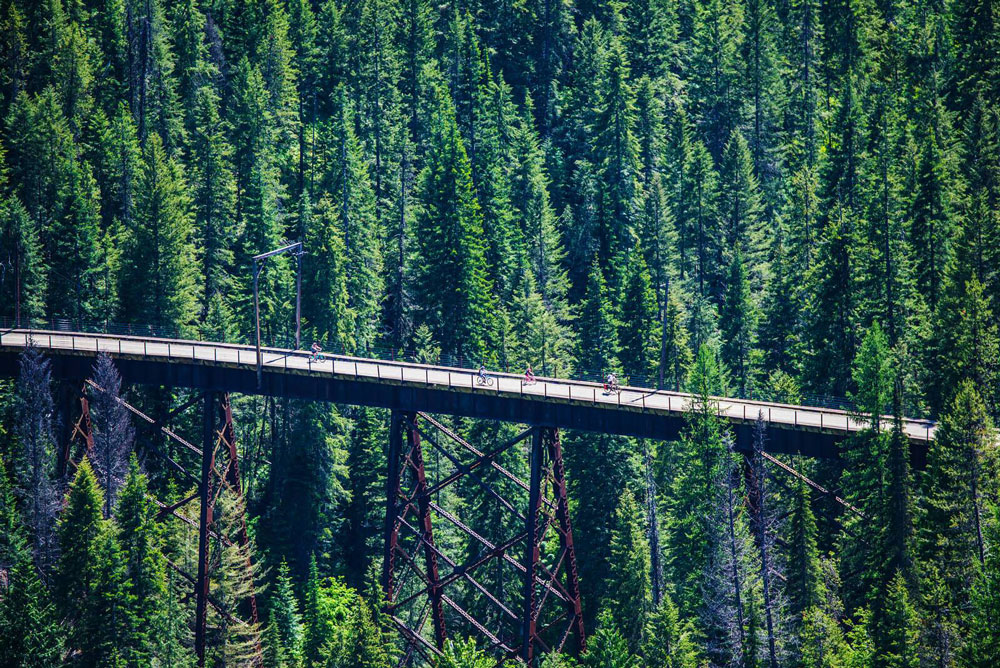Rail-trail corridors welcome new development along the winding routes that carried the industry of yesteryear.
Across the United States, there are more than 26,000 miles of rail-trails on the ground and more than 9,000 miles of rail-trails ready to be built. Chances are you have one near you.
Site Selection’s home base in Atlanta is close to a number of these trails, from the 61-mile Silver Comet to the evolving Firefly Trail in Athens to the Chief Ladiga and Singing River Trail corridors in Alabama and the popular Swamp Rabbit Trail from Greenville to Travelers Rest in Upstate South Carolina.
How do assets like rail-to-trail corridors tip the scale in a positive direction for companies on the hunt for high quality of life? And what can we learn from examining the direct business growth along these same winding pathways?
Analysis of official government statistics on outdoor recreation by Montana-based Headwaters Economics found that bicycling alone contributed $3.7 billion to U.S. GDP in 2023. That’s not counting the prodigious amount cyclists spend on the right outfit and fit-out, which would be part of the apparel and accessories category, No. 1 by far in terms of outdoor recreation GDP at $73 billion.
In 2022 the same firm analyzed the economic potential of the Great American Rail-Trail, a 3,700-mile route through 12 states and the District of Columbia that was 53% complete at the time, with around 150 existing trails on the route and 88 gaps still to fill.
“We find that when fully complete, the trail will attract 25.6 million trips and generate more than $229.4 million in visitor spending each year,” wrote Headwaters Economics researcher Dr. Megan Lawson and Associate Director Kelly Pohl. “It could generate more than $104 million in labor income, 2,500 new jobs, $22.8 million in new tax revenue, and contribute more than $161 million to the gross domestic product each year.”
The budget reconciliation bill signed by President Donald Trump this summer guts federal funding for walking and biking trail development by rescinding around $750 million from the Neighborhood Access and Equity Program. But that doesn’t stop state and local action to develop these corridors.
Asked to highlight specific rail-trail corridors that have spurred economic development, Lawson says by email, “A great example of a region developing around rail-trails is the panhandle of Idaho. The Route of the Hiawatha [15 miles] and Trail of the Coeur d’Alenes [73 miles] run from the Montana to Washington border. It’s brought a lot of revitalization to these areas, especially Wallace, Idaho.”
Known for its 1.66-mile Taft Tunnel, the Route of the Hiawatha is one of only around 30 trails to be named a Rail-Trail Hall of Fame trail by the Rails-to-Trails Conservancy.
In a more urban setting, she says, “the Economic Development Corporation in Lancaster, Pennsylvania, is also leading efforts to use outdoor recreation and their rail-trails to improve quality of life and help with employer and employee recruitment and retention.”
Snapshots From the Trails
Among recent rail-trail highlights:
Known for its work with the 22-mile railroad corridor turned linear lifestyle known as the Atlanta Beltline, Norfolk Southern is partnering with a new trail forming in the Carolinas. In June the railroad finalized the sale of a steep 31.5-mile rail corridor up the Blue Ridge Escarpment to the Saluda Grade Trail Conservancy. The original railroad, built in the 1870s to connect Spartanburg, South Carolina, and Asheville, North Carolina, included this stretch that maxed out at a 5% grade — mortally dangerous for more than one runaway train, but now to be converted to a workout to stave off mortality. The trail route passes through the small towns of Inman, Campobello, Landrum, Tryon, Saluda and Zirconia.
“For many years, people have looked at the unique communities and spectacular scenery along this rail corridor and hoped that one day it could be transformed into a rail-trail with recreational and economic benefits for the entire area,” said Glenn Hilliard, founder and chair of the Saluda Grade Trails Conservancy. “Closing the purchase of the Saluda Grade is a wonderful achievement, and we owe our appreciation to the many partners and contributors who made this possible.”

Rails to Trails Conservancy in December 2024 announced 2,068.6 miles of the Great American Rail-Trail trail are completed, marking the entire route at 55% complete since the vision for the cross-country trail was introduced in 2019.
Map courtesy of Headwaters Economics
The Conservancy notes that another new rail-trail nearby — the 19.4-mile Ecusta Trail being built between Hendersonville and Brevard, North Carolina, along a line that served a paper mill shut down in 2002 — already has attracted popular restaurants and breweries along the route.
The Rails to Trails Conservancy (RTC) continues to work with partners across Missouri to advocate for the completion of the 144-mile Rock Island Trail, which will eventually connect with the 239-mile Katy Trail to create a trail loop from Kansas City and St. Louis. “What is happening in Missouri will be looked back on in a decade or two as a defining moment in the trail movement,” RTC Senior Director of Programs Eric Obergtold writer Laura Stark in an RTC newsletter story last year. “Doubling down on the success of the Katy Trail by developing another cross-state trail, and connecting them into an internationally unique destination, will be remembered as one of the finest projects a state could undertake for the long-term vitality of its smaller rural communities.”
Leighton, Alabama, in June saw a groundbreaking for a new multi-use path that is part of the larger Singing River Trail, a 220-mile greenway system established in 2018 that connects communities across eight northern Alabama counties. The Leighton project was supported by a $1 million Transportation Alternatives Program (TAP) grant from the state.
“A significant portion of our trail is on TVA land,” says Misti Potter, executive director of Singing River Trail. “It’s beneficial for them and us for people to be able to use land that is publicly accessible.”
Potter calls trails “the great equalizer. You don’t have to have special equipment. It doesn’t matter where you come from, the trail is for everyone. Organizations that understand that are literally lifting all boats. It drives the economy. It drives entrepreneurship. It helps the community grow.”

